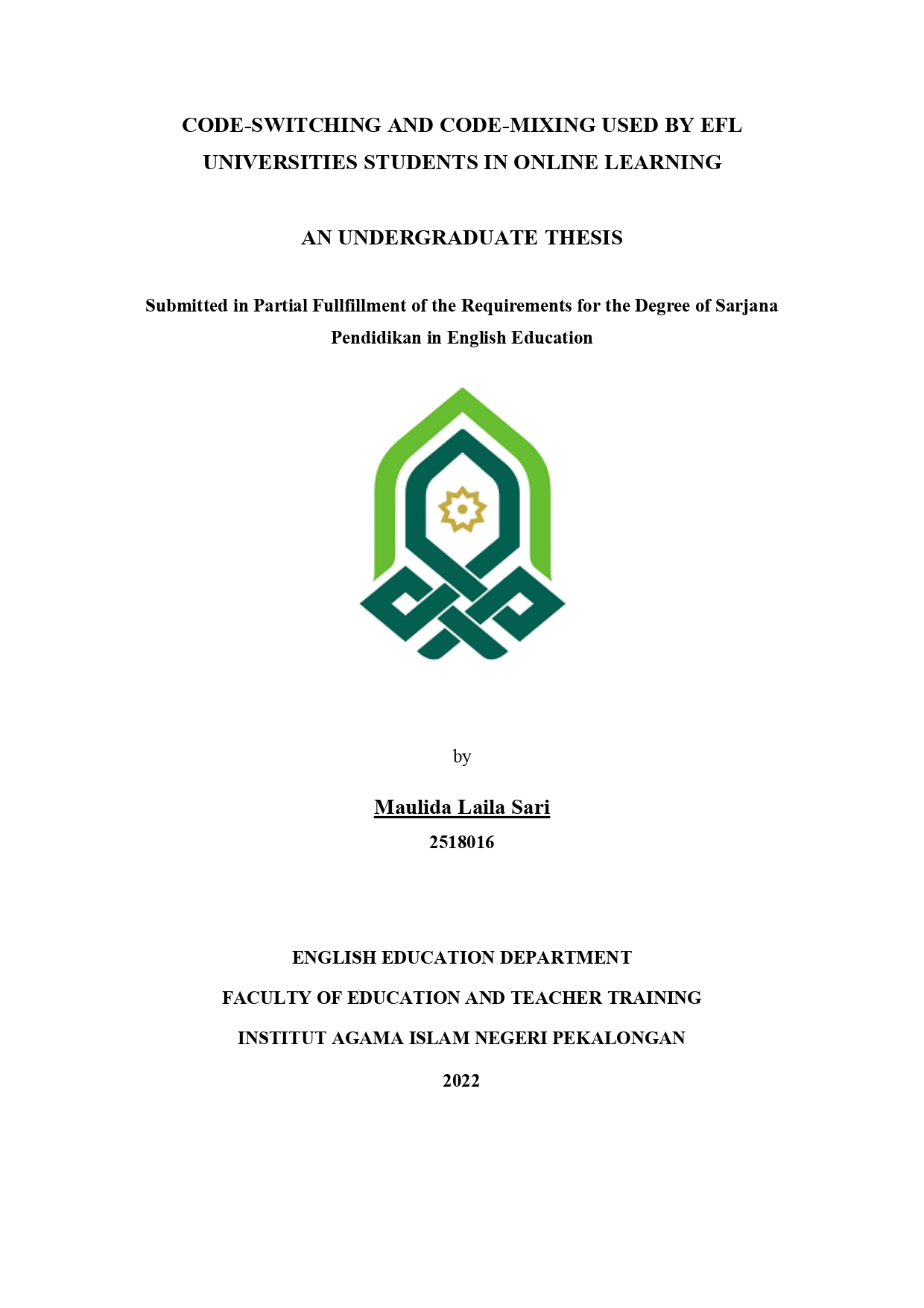
SKRIPSI TADRIS BAHASA INGGRIS
Code-Switching And Code-Mixing Used by EFL Universities Students in Online Learning
In online learning, students often switch and mix codes, Indonesian-English or English Indonesian, in expressing their idea. This study aims to explore why students use code-switching and code-mixing as well as to investigate different kinds of students code-switching and code-mixing in online learning. The researcher employs qualitative approach and narrative inquiry as the research design. In this case, the data were collected through observation, semi-structured interviews and documentation. The thematic analysis of Braun and Clarke was used to analyze the data. This study help to develop the theory of Hoffman and Poplack in the online learning discussion using code-switching and code-mixing. The findings of the study showed the reason students switch and mix codes there are talking about particular topics, quoting somebody else, showing empathy about something, interjection, repetition used for clarification, dan lexical need. The kinds of code-switching used by students are intra-sentential switching, inter-sentential switching, tag switching, and establishing continuity with the previous speaker. Whereas, the kinds of code-mixing used by students are intra-sentential mixing and intra-lexical mixing.
Keywords: Online learning, Code-switching, Code-mixing
REFERENCE
Abdullah, A., & Usman, R. (2021). Students' Perception towards Code-Switching and Code-Mixing in Sociolinguistic: A Case at an English Education Major. EDULINK (Education and Linguistics Knowledge) Journal, 3 (1).
Adams, W. C. (2015). Conducting semi-structured interviews.In: Wholey, J.S., Harty, H.P. and Newcomer, K.E., Eds., Handbook of practical Program Evolution, Jossey-Bass, San Fransisco
Alvarez-Caccamo, Celso. (1998). From switching-code to code-switching: Towards a reconceptualisation of communicative codes. In: Peter Auer, ed. Code-switching in Conversation. Language, interaction, and identity.London: Routledge
Agustina, Kiki. (2018). The Use Of Code-Switching And Code-Mixing By English Teacher At Man Kota Palangka Raya. Thesis, English Language Education.State Islamic Institute Of Palangkaraya
Aras, L. (2019). Pengaruh penggunaan Media Blok Pecahan terhadap Minat Belajar Pada Mata Pelakaran Matematika Siswa kelas III SD Kompleks Lariang Bangi Kecamatan Makassar Kota Makassar, JIKAP PGSD: Jurnal Ilmiah Ilmu Kependidikan, 3(1), 40, https://doi.org/10.286858/jkp.v3i1.8164.
Aslinda&Leni, S. (2007). Introduction to Sociolinguistics. Bandung: PT. RefikaAditama
Bahasa, M. P., Struktural, P., Bahasa, M. P., & Struktural, P. (n.d.). Metode Penelitian Bahasa: Pendekatan Struktural 1 2 Metode Penelitian Bahasa: Pendekatan Struktural.
Baskervill, B., & Robb, T. (2005). Using Moodle for Teaching Business English in a CALL environment. PacALL Journal, 1(1), 138-151. Retrieved March 10, 2009, from http://www.paccall.org/Journal/V-1-1papers/Baskerville-Robb-moodle-teaching.pdf.
Barkhuizen, G., Benson, P., & Chik, A., (2014). Narrative Inquiry in Language Teaching and Learning Research
Braun, V., & Clarke, V. (2008). Using thematic analysis in psychology,Qualitative Research in Psychology. Journal of Chemical Information and Modeling, 3(2), 77–101. http://dx.doi.org/10.1191/1478088706qp063oa
Bullock, B. E. & Toribio, A. J. (2004). trying to hit a moving target: on the sociophonetics of code-switching. In I.. Isurin, D. Winford, & K. De Bot (Eds.), Multidisciplinary Approaches to Code-Switching (pp. 9-16). Sometville, MA: Cascadilla Proceeding Project.
Casielles, E.-Suarez. (2017). The syntax-information Structure Interface. Evidence from Spanish and English. New York: Routledge
Clandinin, D. J.; Conelly, F. M. (2000). Narrative Inquiry: Experience and story in qualitative research. San Fransisco: Jossey-Bass
Ketersediaan
| 23SK2325030.00 | SK TI 23.030 MAU c | My Library (Lantai 3. Local Content) | Tersedia |
Informasi Detail
- Judul Seri
-
-
- No. Panggil
-
SK TI 23.030 MAU c
- Penerbit
- Pekalongan : Jurusan S-1 Tadris Bahasa Inggris FTIK UIN K.H. Abdurrahman Wahid Pekalongan., 2022
- Deskripsi Fisik
-
xiv, 56 hlm., 30 cm; Bibliografi: 57-59
- Bahasa
-
Inggris
- ISBN/ISSN
-
-
- Klasifikasi
-
302. 22
- Tipe Isi
-
-
- Tipe Media
-
-
- Tipe Pembawa
-
-
- Edisi
-
-
- Subjek
- Info Detail Spesifik
-
-
- Pernyataan Tanggungjawab
-
Maulida Laila Sari (2518016)
Versi lain/terkait
Tidak tersedia versi lain
Lampiran Berkas
Komentar
Anda harus login sebelum memberikan komentar
 Karya Umum
Karya Umum  Filsafat
Filsafat  Agama
Agama  Ilmu-ilmu Sosial
Ilmu-ilmu Sosial  Bahasa
Bahasa  Ilmu-ilmu Murni
Ilmu-ilmu Murni  Ilmu-ilmu Terapan
Ilmu-ilmu Terapan  Kesenian, Hiburan, dan Olahraga
Kesenian, Hiburan, dan Olahraga  Kesusastraan
Kesusastraan  Geografi dan Sejarah
Geografi dan Sejarah